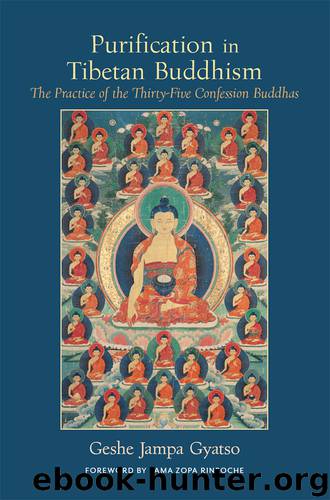Purification in Tibetan Buddhism by Geshe Jampa Gyatso

Author:Geshe Jampa Gyatso
Language: eng
Format: epub
Publisher: Wisdom Publications
There is some difference of opinion between the Lesser and Greater Vehicles concerning whether or not we can actually commit the action of immediate retribution of causing blood to flow from the body of a tathāgata. According to the vinaya teachings this action can only be committed in relation to the body of Shākyamuni Buddha; consequently, it would be impossible for us to commit it. However, the Great Vehicle asserts that this action can be committed in relation to any tathāgata and, therefore, it would indeed be possible for us to commit it. Regardless of this difference of opinion, it is unlikely that we have committed this action in this life; nor is it likely that we have killed our father, our mother, or a foe-destroyer. On the other hand, it is impossible for us to have committed the action of immediate retribution of creating a schism in the sangha. This is because this particular action of immediate retribution is specifically related to an event that occurred during the lifetime of Shākyamuni Buddha when Devadatta imposed five mandatory practices that resulted in controversy within the monastery. The five practices were (1) to not eat meat because it involves the killing of sentient beings, (2) to not eat salty food because it causes attachment, (3) to not drink milk because it harms the suckling calf, (4) to not wear cut and sewn clothes because it harms the weavers, and (5) to not stay in solitary places because it does not benefit other people. Fortunately, harmony was quickly restored by two of Buddha’s disciples, Shāriputra and Maudgalyāyana. In consequence, their presence, as well as that of Shākyamuni Buddha himself, is necessary to commit the action of immediate retribution of creating a schism in the sangha. In this lifetime, if we were to cause a division among the sangha, while it would be a great negativity, it would not be an action of immediate retribution.
Furthermore, according to the root tantra of Guhyasamāja, abandoning the Dharma is equivalent to the action of immediate retribution of creating a schism in the sangha, and breaking or destroying a statue of the Buddha is equivalent to the action of immediate retribution of causing blood to flow from a tathāgata. Therefore, according to tantra, it is possible that we have committed all five actions of immediate retribution at some time in this or past lives. Although we may not have committed any of them in this life, since we do not know with certainty that we did not do them in other lives, we need to purify them. For this reason, the actions of immediate retribution that we have directly and indirectly committed and the negativities accumulated by having rejoiced in others’ doing of them are indicated as negativities to be confessed.
The Negativities Included in the Ten Non-virtues
Whatever of the ten non-virtuous paths of action I have engaged in the adoption of, caused to be engaged in, or rejoiced in the engagement in…
Download
This site does not store any files on its server. We only index and link to content provided by other sites. Please contact the content providers to delete copyright contents if any and email us, we'll remove relevant links or contents immediately.
| Clergy | Devotionals |
| Faith | Inspirational |
| Meditations | Monasticism & Asceticism |
| Prayer | Prayerbooks |
| Ritual | Sermons |
More Language of Letting Go: 366 New Daily Meditations by Melody Beattie(2469)
The Holy Spirit by Billy Graham(2451)
To Light a Sacred Flame by Silver RavenWolf(2372)
The Secret Power of Speaking God's Word by Joyce Meyer(2275)
Tuesdays With Morrie by Mitch Albom(2194)
The Lost Art of Good Conversation by Sakyong Mipham(2142)
The Traveler's Gift by Andy Andrews(2031)
Kundalini by Gopi Krishna(1841)
A Kingsbury Collection by Karen Kingsbury(1731)
Finding Chika by Mitch Albom(1660)
Angels of God: The Bible, the Church and the Heavenly Hosts by Mike Aquilina(1644)
As a Man Thinketh by James Allen(1589)
Angels by Billy Graham(1566)
The Yoga of Jesus: Understanding the Hidden Teachings of the Gospels by Paramahansa Yogananda(1541)
Curse Tablets and Binding Spells from the Ancient World by Gager John G.;(1527)
Barking to the Choir by Gregory Boyle(1513)
Autobiography of a Yogi (Complete Edition) by Yogananda Paramahansa(1505)
Anxious for Nothing by Max Lucado(1420)
How To Be Born Again by Billy Graham(1418)
